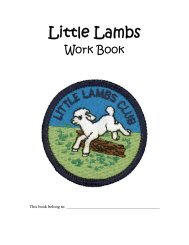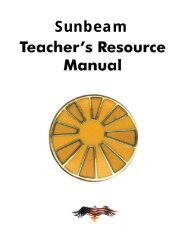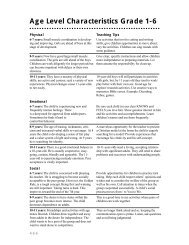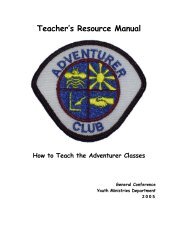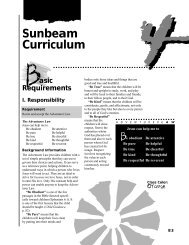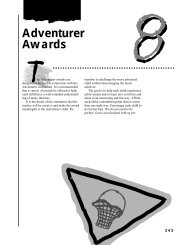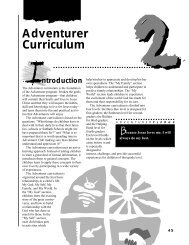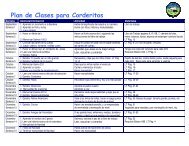Busy Bee Curriculum - KFW Adventurers
Busy Bee Curriculum - KFW Adventurers
Busy Bee Curriculum - KFW Adventurers
Create successful ePaper yourself
Turn your PDF publications into a flip-book with our unique Google optimized e-Paper software.
C H A P T E R T H R E E B U S Y B E E<br />
○ ○ ○ ○ ○ ○ ○ ○ ○ ○ ○ ○ ○ ○ ○ ○ ○ ○ ○ ○ ○ ○ ○ ○<br />
S T E P B Y S T E P<br />
Making a Bible Story Chart<br />
○ ○ ○ ○ ○ ○ ○ ○ ○ ○ ○ ○ ○ ○ ○ ○ ○ ○ ○ ○ ○ ○ ○ ○ ○ ○ ○ ○ ○ ○ ○ ○ ○ ○ ○ ○ ○ ○ ○ ○ ○ ○ ○ ○ ○ ○ ○ ○ ○ ○ ○ ○ ○ ○ ○ ○ ○ ○ ○ ○ ○ ○<br />
The Bible Story Chart will help children understand<br />
Bible history by experiencing it visually and actively.<br />
A simple method for making a basic story chart is<br />
described below. It is designed for use within the<br />
smaller pictures and labels provided. The measurements<br />
may need to be larger if you desire to use larger pictures.<br />
Materials<br />
• Eight sheets of 9" x 12" purple construction paper<br />
• Two sheets of 9" x 12" yellow construction paper<br />
• Rubber cement or craft glue<br />
• Pictures provided on the following pages or<br />
collected to illustrate the stories studied in the<br />
classroom or Sabbath School<br />
• Clear contact paper or laminating film<br />
Directions<br />
1. Glue the purple paper together end to end to make<br />
a long, narrow length of paper, as illustrated on<br />
the following page. The six sheets represent the<br />
6,000 years of Biblical history. The dark color<br />
represents the earth suffering from evil and sin.<br />
2. Next, glue one sheet of yellow paper to each end<br />
of the purple paper. Yellow represents the time of<br />
joy and happiness before sin entered, and the<br />
time when Jesus comes again to destroy sin and<br />
take us to heaven. Cut the yellow sheets in a<br />
wavy line. This shows that time continues forever<br />
in both directions.<br />
3. Copy the smaller pictures, labels and stories<br />
provided. Color them, cut them out, and mount<br />
them on heavier paper.<br />
4. The chart may now be hung on the wall or used<br />
in presenting or practicing the story. The story<br />
chart and its parts may be laminated or covered<br />
with clear contact paper to allow children to<br />
manipulate it freely without fear of damage.<br />
5. The children may create their own smaller charts<br />
in this way. They may use smaller dimensions.<br />
The diagram on the next page shows how the<br />
stories for each year fit together on the story chart<br />
to make a whole.<br />
6. Large pictures are located in the appendix section<br />
at the end of the manual.<br />
Four Year Composite Wall Chart<br />
<strong>Busy</strong> <strong>Bee</strong><br />
Sunbeam<br />
Builder<br />
Helping Hand<br />
65



